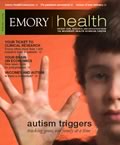Growing new brain cells
 Anthony Chan’s research found that dental pulp stem cells from rhesus macaques show promise for developing therapies for central nervous system diseases, such as Huntington’s and Parkinson’s. |
A curious thing happened soon after Emory geneticist Anthony Chan implanted stem cells from the tooth of a rhesus macaque into the brains of mice.
After a few days, the stem cells began to disappear. Meanwhile, new neural cells—many of them neurons—had begun to form. The research was published in Stem Cells in 2008.
Considered adult stem cells, dental stem cells can regenerate many different types of cells. In light of Chan’s research, dental pulp stem cells show promise for cell therapy and regenerative medicine, specifically for therapies associated with the central nervous system, such as Huntington’s and Parkinson’s. So far, dental pulp cells have been used to regenerate dental and craniofacial cells.
The proliferation of adult stem cells is easier to control than that of embryonic stem cells, which have the potential of becoming tumors. "You want the cells to do their job and be gone," says Chan, a geneticist in Emory's Department of Human Genetics and researcher at Yerkes National Primate Research Center.
Because dental pulp stem cells can be isolated from anyone at any age, Chan is interested in the possibility of people banking their cells. Being able to use your own stem cells for therapy would greatly decrease the risk of cell rejection that we now experience in transplant medicine, he says.
The latest research from Chan and his team examines whether dental pulp stem cells from monkeys with Huntington’s disease can enhance brain cell development in the same way that dental pulp stem cells from healthy monkeys do. Chan's group developed the first transgenic monkey model for Huntington's disease in 2008.


